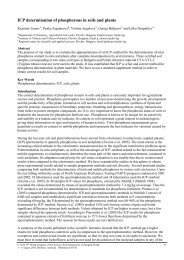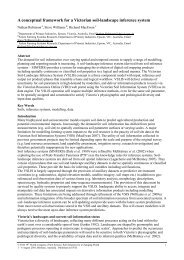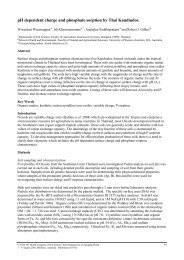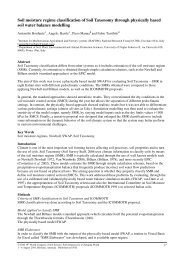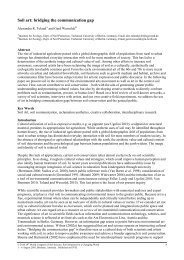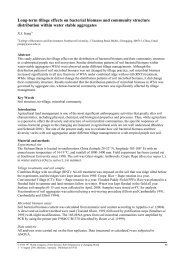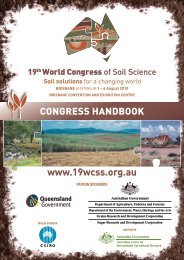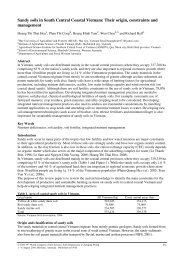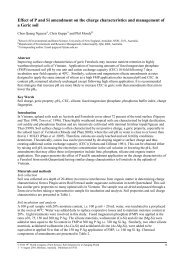Greywacke weathering under tropical climate: Chemical and ...
Greywacke weathering under tropical climate: Chemical and ...
Greywacke weathering under tropical climate: Chemical and ...
Create successful ePaper yourself
Turn your PDF publications into a flip-book with our unique Google optimized e-Paper software.
<strong>Greywacke</strong> <strong>weathering</strong> <strong>under</strong> <strong>tropical</strong> <strong>climate</strong>: <strong>Chemical</strong> <strong>and</strong> mineralogical<br />
changes (example from central-Brazil)<br />
Edi Mendes Guimarães<br />
Instituto de Geociências, University of Brasília, Brasília, DF, Brazil, Email rxedi@unb.br<br />
Abstract<br />
<strong>Greywacke</strong>s are matrix-rich s<strong>and</strong>stone, in general, containing chemically unstable minerals, which <strong>under</strong><br />
<strong>tropical</strong> <strong>weathering</strong> conditions give origin to thick <strong>weathering</strong> profiles, depleted in base cations <strong>and</strong> rich in<br />
metals hydroxides. This work deals with a thin <strong>weathering</strong> profile developed on a proterozoic greywacke,<br />
<strong>under</strong> <strong>tropical</strong> conditions in central-Brazil. The rock presents a fine-grained texture <strong>and</strong> is mainly composed<br />
of quartz, feldspars <strong>and</strong> phyllosilicates. Initial <strong>weathering</strong> yields exp<strong>and</strong>able clay minerals <strong>and</strong> opaque<br />
minerals (Fe-oxihydroxides), which replace phyllosilicates <strong>and</strong> form euhedral crystals. From fresh rock to<br />
the most altered level, K2O <strong>and</strong> Na2O decrease, Fe2O3 increases, but Mg remains almost constant. The finegrained<br />
texture of the rock, <strong>and</strong> exp<strong>and</strong>able clay minerals produced in the first stage of alteration inhibit<br />
water infill in the rock, explaining the narrow level of <strong>weathering</strong>. This study reinforces the role of the parent<br />
rock in the <strong>weathering</strong>, even <strong>under</strong> <strong>tropical</strong> conditions.<br />
Key Words<br />
Greyawcke, Fe-oxide, interstratified clay minerals, smectite, electron microprobe, X-ray diffraction<br />
Introduction<br />
In <strong>tropical</strong> <strong>and</strong> equatorial <strong>climate</strong>s, soils are very thick <strong>and</strong> mainly formed of kaolinite combined with Al <strong>and</strong><br />
Fe-oxihydroxides, even where the composition of parent rocks is different. However, the composition of<br />
parent materials is of decisive importance for the beginning of <strong>weathering</strong>, when mineral composition <strong>and</strong><br />
water flow control the products of alteration (Meunier, 2005). The mainly chemical <strong>and</strong> mineralogical<br />
transformations lead leaching of base cations <strong>and</strong> Si, result in formation of kaolinite <strong>and</strong> oxidation of iron<br />
<strong>and</strong> manganese. Weathering of chlorite is characterized by both Fe oxidation <strong>and</strong> leaching of Mg yielding<br />
vermiculites <strong>and</strong> smectites (Newman, 1982). On l<strong>and</strong>scape modeled by differential erosion, hills are<br />
sustained by resistant rocks. In central Brazil, the <strong>tropical</strong> <strong>climate</strong> is characterised by annual precipitation of<br />
approximately 1600 mm with a wet season from October to March <strong>and</strong> a mean temperature ranging from 18<br />
to 22°C. Erosional processes produce plateaus sustained mainly by granites, quartzites, s<strong>and</strong>stones <strong>and</strong><br />
lateritic crusts, but some are maintained by greywackes from the proterozoic Três Marias Formation<br />
(Bambuí Group). Despite the chloritic matrix <strong>and</strong> plagioclase content, the alteration profiles on these<br />
greywackes are only a few centimeters in depth <strong>and</strong> the plateau surfaces are covered by s<strong>and</strong> among<br />
boulders, cobbles <strong>and</strong> pebbles produced by spheroidal <strong>weathering</strong>. On boulders <strong>and</strong> cobbles, alteration<br />
occurs from the surface to the core, in which parental rock is preserved. In this paper we present the initial<br />
mineralogical change on the greywacke <strong>and</strong> the possible mechanism that limits the <strong>weathering</strong> on the<br />
surface. Indeed, mineralogical studies allow a better <strong>under</strong>st<strong>and</strong>ing of the processes of soils formation <strong>and</strong><br />
better determine the rate of soil processes (Cornu et al., 2009).<br />
Methods<br />
The study was carried out on a representative greywacke cobble (15 cm) from Três Marias Formation<br />
collected on a plateau near Cabeceiras town, Goiás, Brazil (S 15° 46’ - W 48°23’). Three samples were<br />
selected: a fresh parent rock, an incipient altered rock <strong>and</strong> an altered level (Figure 1).<br />
a<br />
Sample Macroscopic characteristics<br />
EGC 37 II a Medium yellowish brittle level (2 cm thickness)<br />
at surface of the cobble, with strong alteration.<br />
b<br />
EGC 37 II b Medium grey brownish level (3 cm thickness<br />
c<br />
with incipient alteration, surrounding the core.<br />
Figure 1. Macroscopic characteristics of greywacke samples.<br />
© 2010 19 th World Congress of Soil Science, Soil Solutions for a Changing World<br />
1 – 6 August 2010, Brisbane, Australia. Published on DVD.<br />
EGC 37 II c Dark grey greenish hard rock in the 6 cm core<br />
without alteration features.<br />
24
Polished thin sections of samples were studied by both conventional petrographic microscopy <strong>and</strong><br />
microprobe. Bulk chemical analyses of major elements were determined after acid digestion (hot, conc.<br />
HF, HClO4, HNO3 <strong>and</strong> HCl) of finely ground samples. Analyses were performed using ICP-AES for Si,<br />
Ti, Fe, Ca <strong>and</strong> Mg determination <strong>and</strong> ICP-MS for Na <strong>and</strong> K. X-ray diffraction (XRD) analyses were<br />
performed using a Rigaku D/Max diffratometer with Cu radiation, <strong>under</strong> 35 kV <strong>and</strong> 13 mA, on fine earth (<<br />
0,1mm) powders from whole samples <strong>and</strong> clay-sized fraction isolated by centrifuge <strong>and</strong> prepared by<br />
conventional technics: air-dried, <strong>and</strong> later solvation by ethylene-glycol for 12 hours. Elemental analysis of<br />
the minerals was made on polished thin sections, using a CAMECA/Camebax electron microprobe with<br />
operating conditions of 15kV, beam current of 5 to 10 mA <strong>and</strong> counting time of 10-15 sec. per element with<br />
a spot size of about 2 µm. Analyzed phyllosilicates are chlorite <strong>and</strong> interstratified clay minerals. Structural<br />
formulae for chlorite are calculated on the basis of 56 negative charges <strong>and</strong> assuming all iron as ferrous.<br />
Analyses with high Na, Ca <strong>and</strong> K contents <strong>and</strong> low octahedral occupancy have been interpreted as intimate<br />
intergrowths of mica <strong>and</strong> chlorite, or even mixed-layer clay minerals.<br />
Results<br />
Mineralogical composition is quite different in three samples (Figure 2). Fresh rock (EGC 37 II c) consists of<br />
more than 15% matrix constituted of an intimate intergrowth of illite <strong>and</strong> chlorite beside opaque minerals.<br />
The grains are 35% quartz, 30% feldspar mainly plagioclase, 12% of phyllosilicates (muscovite, biotite,<br />
chlorite) <strong>and</strong> the rest are opaque minerals, tourmaline <strong>and</strong> zircon. Micas <strong>and</strong> chlorite occur as clear laminae<br />
or are small lamella in lithic grains, with typical pleochroism. Biotite <strong>and</strong> muscovite are brown <strong>and</strong> white,<br />
respectively <strong>and</strong> chlorite is green or grey. Opaque minerals are euhedral crystals inside detrital grains, or<br />
micro-crystals along cleavage planes in phyllosilicates <strong>and</strong> somewhere replace partially other minerals.<br />
In the level surrounding the core (EGC 37 II b) the composition is similar to fresh rock, feldspar being<br />
preserved, but phyllosilicates present changes: most of them become brownish <strong>and</strong> some are completely<br />
replaced by opaque minerals. In the most altered level (EGC 37 II a), some K-feldspars are still preserved,<br />
while all the phyllosilicate have lost their original colour or have been completely replaced by opaque<br />
minerals.<br />
X-ray diffratograms from whole samples show typical reflections for quartz, illite <strong>and</strong> feldspar (Figure 3).<br />
The 14 reflection from chlorite is low, the 7 <strong>and</strong> reflections are high (coincident with kaolinite), while, 4.7 is<br />
present in both fresh rock <strong>and</strong> incipiently altered rock, but do not appear in most altered sample.<br />
In clay fraction, quartz <strong>and</strong> feldspar reflections are low or missing, while phyllosilicates have high peaks.<br />
Fresh rock (EGC 37 II c) presents a distinct 14 Å reflection that does not exp<strong>and</strong> <strong>under</strong> solvation by<br />
ethylene-glycol, characteristic of chlorite. This same reflection in EGC 37 II b displaces to 16 Å, indicating a<br />
smectite <strong>and</strong> it appears a 30 reflection <strong>under</strong> solvation by glycerol. These reflections indicate both the<br />
presence of smectite <strong>and</strong> an interstratified clay mineral. The most altered sample (EGC 37II a) presents<br />
kaolinite peaks <strong>and</strong> a high background.<br />
Table 1 shows the chemical composition of the whole rock is quite different from one sample to another. Si,<br />
Al <strong>and</strong> Mg contents in the whole rock are almost constant in three samples. From fresh rock to the most<br />
altered, Fe2O3 increases, while Na2O <strong>and</strong> K2O decrease.<br />
Table 1. <strong>Chemical</strong> composition of greywacke (whole rock).<br />
Samples SiO2 Ti O2 Al2O3 Fe2O3 MgO CaO Na2O K2O P2O5 LOI Total<br />
ECG-37IIa 73.94 1.06 10.23 5.99 1.32 0.31 0.33 0.62 0.12 6.10 99.83<br />
ECG-37IIb 78.52 0.65 10.07 2.86 1.22 0.46 1.19 1.21 0.12 2.61 98.92<br />
ECG-37IIc 72.91 0.70 10.88 3.36 1.56 0.54 2.34 1.89 0.11 2.73 97.02<br />
Elemental analyses (Table 2) show Fe-chlorite in fresh rock wich low vacance in octahedral site. In incipient<br />
altered rock, chlorites like lamelaes have more high octahedral vacance, that is atributed to oxidation state of<br />
iron <strong>and</strong> seems to indicate presence of smectite, or vermiculite, where Mg is high. In the most altered<br />
sample, the phyllosilicates like lameleas presents highest vacance in octahedral site (Figure 4) calculated as<br />
chlorite <strong>and</strong> high Fe content, that may be correspond to mixture or interestratified Fe-Kaolin (Ryan &<br />
Huerta, 2009).<br />
© 2010 19 th World Congress of Soil Science, Soil Solutions for a Changing World<br />
1 – 6 August 2010, Brisbane, Australia. Published on DVD.<br />
25
Table 2. Elemental composition (%) of phyllisilicates calculated as chlorite.<br />
SAMPLES Si Al(t) Al(o) Fe Mg Ti Oct Ca Na K Alc<br />
ECG-37IIa 6.2-7.8 1.8-0.2 3.5-4.8 2.1-4.3 1.8-4.0 0.0-0.02 9-10.6<br />
10.7-<br />
0-0.1 0.1-0.2 0.1-0.5 0.2-0.3<br />
ECG-37IIb 6.0-6.8 2.0-1.2 2.7-3.1 3.4-4.4 3.0-4.8 0.0-0.1 11.7 0-0.1 0-0.2 0.1-0.3 0.1-0.2<br />
10.8-<br />
0.07-<br />
ECG-37IIc 5.8-6.2 2.2-1.8 2.4-2.6 4.2-6.5 3.2-4.2 0-0.1 11.9 0-0.01 0-0.1 0-0.2 0.2<br />
A<br />
C<br />
1 mm 0,5 mm<br />
0,5 mm 1 mm<br />
Figure 2. <strong>Greywacke</strong> <strong>under</strong> microscope: A) line indicates the contact between EGC 37 II c (fresh rock) <strong>and</strong> EGC<br />
37 II b (incipient altered rock; B) detail on fresh rock, with green chlorite; C) detail on incipient altered rock:<br />
phyllosilicates are brown <strong>and</strong> some are replaced by opaque minerals; D) most altered rock: opaque minerals<br />
replace almost all phyllosilicates.<br />
© 2010 19 th World Congress of Soil Science, Soil Solutions for a Changing World<br />
1 – 6 August 2010, Brisbane, Australia. Published on DVD.<br />
B<br />
D<br />
26
Figure 3. Diffractogram of clay fraction of EGC 37 IIb: O - oriented powder air-dried; G – solvated in ethyleneglycol;<br />
S – solvated in glycerol.<br />
12<br />
11<br />
10<br />
9<br />
8<br />
5 5,5 6 6,5 7 7,5 8<br />
Figure 4. Octahedral occupation (Y axis) <strong>and</strong> Si content (X axis) in phyllosilicates calculate as chlorites: ▲–<br />
fresh rock; ♦– incipient altered rock; ■ – most altered sample.<br />
Conclusion<br />
From the fresh rock to altered one, the studied greywacke behaves as expected in some aspects <strong>and</strong> is<br />
different in others. Smectite <strong>and</strong> vermiculite are produced in the first stage of alteration <strong>and</strong> disappear in the<br />
surface, where kaolinite remains; Fe2O3 increases, while Na2O <strong>and</strong> K2O decrease. However, Mg <strong>and</strong> Al2O3<br />
contents remain almost constant in all samples. Mg content corresponds to vermiculite <strong>and</strong> interstratified<br />
clay minerals calculated by microprobe analyses <strong>and</strong> identified by XRD. The high background in XRD of<br />
most altered sample indicates high content in iron. The thin <strong>weathering</strong> profile is attributed to fine grained<br />
rock <strong>and</strong> the expansive clay minerals in the first stage of alteration, inhibiting the water infill in the fresh<br />
rock. This work shows that the parent rock plays a decisive role in the beginning of <strong>weathering</strong> <strong>and</strong> can<br />
determines the path of the soil formation.<br />
References<br />
Cornu S, Montagne D, Vasconcelos PM (2009) Dating constituent formation in soils to determine rates of<br />
processes: A review. Geoderma 153, 293-303.<br />
Meunier A (2005) Clays. Spring, Berlin. 472 pp.<br />
Newman ACD (1987) Chemistry of clays <strong>and</strong> clay minerals. Mineralogical Society Monograph 6,<br />
Mineralogical Society, 480 pp.<br />
Ryan PC, Huertas (2009) The temporal evolution of pedogenic Fe-smectite to Fe-kaolin via interstratified<br />
kaolin-smectite in a moist <strong>tropical</strong> soil chronosequence. Geoderma 151, 1-15.<br />
© 2010 19 th World Congress of Soil Science, Soil Solutions for a Changing World<br />
1 – 6 August 2010, Brisbane, Australia. Published on DVD.<br />
S<br />
G<br />
O<br />
27



